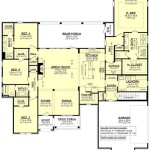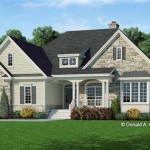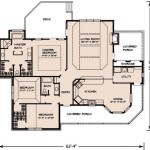The Allure of the Open Floor Plan Split Level Home
The open floor plan split level home represents a unique architectural style that combines the spaciousness of modern open concepts with the functional zoning offered by the split level design. This hybrid model provides a versatile living environment suitable for a variety of lifestyles, making it a popular choice for homeowners seeking both style and practicality.
Split level homes, characterized by their staggered floor layouts, were initially popularized in the mid-20th century as a response to the growing need for affordable and functional housing in suburban areas. The open floor plan, with its emphasis on light, flow, and connectivity, gained traction later as an alternative to compartmentalized traditional layouts. The fusion of these two styles creates a dynamic residential space that addresses both the demand for spaciousness and the need for clearly defined zones.
This article will explore the key characteristics of the open floor plan split level home, examining the advantages and potential disadvantages of this design. Furthermore, it will delve into the aspects of design and décor considerations that optimize the functionality and aesthetic appeal of this type of residence. Ultimately, the aim is to provide a comprehensive understanding of the open floor plan split level home, enabling prospective homeowners to make informed decisions about its suitability for their specific needs and preferences.
Key Benefits of Combining Open Floor Plans and Split Level Design
The synthesis of open floor plans and split level architecture offers a compelling combination of benefits that cater to diverse needs. The open floor plan facilitates a sense of spaciousness and connection, while the split level design provides distinct zones for various activities. This synergy allows for both communal living and private retreat within the same residence.
One of the most significant advantages is the enhanced sense of spaciousness. By eliminating interior walls, the open floor plan creates a larger, more unified living area. This is particularly beneficial for families who value interaction and togetherness. The unobstructed sightlines also improve natural light penetration, making the home feel brighter and more inviting.
Another key benefit lies in the functional zoning inherent in the split level design. The staggered floor levels naturally delineate different areas of the home, such as the living room, dining area, and kitchen, without the need for solid walls. This allows for a clear separation of functions while maintaining a sense of openness. For example, the main living area might be on one level, while the bedrooms are located on a slightly higher or lower level, providing added privacy and quiet.
The split level aspect can also contribute to energy efficiency. The varying levels can create natural insulation and ventilation, potentially reducing heating and cooling costs. The design can also be adapted to take advantage of natural sunlight and airflow, further enhancing energy conservation. Furthermore, the staggered levels can provide opportunities for passive solar heating and cooling, depending on the orientation of the house.
Finally, open floor plan split level homes often offer increased flexibility in terms of design and layout. The absence of interior walls allows for greater customization, enabling homeowners to tailor the space to their specific requirements. This adaptability makes the open floor plan split level home a suitable choice for individuals and families with diverse lifestyles and changing needs.
Potential Challenges and Considerations
While the open floor plan split level home offers numerous advantages, it also presents certain challenges that need to be considered during the planning and design stages. These challenges primarily relate to noise control, privacy, and visual coherence within the open space.
Noise control can be a significant issue in open floor plans. The absence of walls allows sound to travel freely throughout the space, potentially disrupting activities and impacting the overall comfort of the home. This is particularly relevant in split level homes, where the different levels can amplify sound transmission. Strategies for mitigating noise include the use of sound-absorbing materials, such as carpets, rugs, and acoustic panels. Furniture arrangement can also play a role in reducing noise levels, creating natural barriers to sound waves.
Privacy can also be a concern in open floor plans. The lack of physical barriers can make it difficult to create private spaces for individual activities. This is especially important in areas such as bedrooms and home offices. In split level homes, the staggered levels can provide some degree of privacy, but it is often necessary to supplement this with additional measures. Solutions include the use of strategically placed screens, curtains, or bookcases to create visual and acoustic separation. The incorporation of pocket doors or sliding partitions can also provide temporary privacy when needed, without compromising the open feel of the space.
Maintaining visual coherence in an open floor plan split level home can be a challenge. The different levels and interconnected spaces can create a sense of visual clutter if not carefully managed. It is important to establish a consistent design aesthetic throughout the home, using a cohesive color palette, similar materials, and complementary furniture styles. The use of focal points and visual anchors can also help to unify the space and create a sense of order. Careful attention to lighting is also crucial, ensuring that the different areas are adequately illuminated and that the lighting scheme complements the overall design.
Structural considerations are also important when planning an open floor plan split level home. Removing interior walls can impact the structural integrity of the building, particularly if the walls are load-bearing. It is essential to consult with a qualified structural engineer to assess the impact of any proposed modifications and to ensure that the structure remains sound. This may involve the installation of beams, columns, or other structural supports to compensate for the removal of load-bearing walls. Furthermore, the existing layout of the split level home may limit the extent to which the open floor plan can be implemented. It is important to carefully evaluate the existing structure and design to determine the feasibility of the proposed modifications.
Finally, the resale value of an open floor plan split level home should be considered. While open floor plans are generally popular, some buyers may prefer more traditional, compartmentalized layouts. The split level design itself may also appeal more to some buyers than others. It is important to research the local real estate market to determine the demand for open floor plan split level homes in the area. Furthermore, the quality of the design and the extent to which the home is well-maintained will also impact its resale value.
Design and Décor Considerations for Open Floor Plan Split Level Homes
Optimizing the functionality and aesthetic appeal of an open floor plan split level home requires careful consideration of design and décor elements. The goal is to create a space that is both visually appealing and conducive to comfortable living. This involves selecting appropriate furniture, lighting, flooring, and color schemes that complement the open layout and enhance the overall flow of the home.
Furniture selection is crucial in defining zones within an open floor plan. Instead of solid walls, furniture groupings can be used to create distinct areas for living, dining, and relaxing. For example, a large area rug can delineate a living room area, while a dining table and chairs can define the dining space. Sectional sofas, bookshelves, and console tables can also serve as visual barriers, creating a sense of separation without completely closing off the space. The scale and proportion of the furniture should be carefully considered to ensure that it complements the open layout and does not overwhelm the space. It is also important to maintain consistent style throughout the different zones, using similar materials, colors, and designs to create a cohesive look.
Lighting plays a critical role in setting the mood and enhancing the visual appeal of an open floor plan split level home. A combination of natural and artificial light sources is essential. Maximizing natural light penetration is crucial, utilizing large windows and skylights whenever possible. Artificial lighting should be layered, incorporating ambient, task, and accent lighting to create a balanced and functional lighting scheme. Ambient lighting provides overall illumination, while task lighting focuses on specific areas, such as reading nooks or kitchen counters. Accent lighting is used to highlight architectural features or decorative elements. Dimmers can be used to adjust the brightness of the lights, allowing for greater control over the ambiance of the space.
Flooring is another important design consideration. The flooring material should be durable, easy to maintain, and visually appealing. Hardwood, tile, and laminate are popular choices for open floor plans. Using different flooring materials in different zones can help to define those areas visually. For example, hardwood flooring might be used in the living and dining areas, while tile flooring is used in the kitchen. Area rugs can also be used to add warmth and texture to the space, as well as to delineate different zones. The color and pattern of the flooring should complement the overall design aesthetic and create a sense of continuity throughout the home.
Color schemes play a significant role in creating a cohesive and visually appealing open floor plan split level home. A consistent color palette should be used throughout the home, with variations in tone and intensity to create visual interest. Neutral colors, such as white, gray, and beige, are often used as a base, with pops of color added through accessories, artwork, and accent furniture. The color scheme should also consider the natural light in the space, as colors can appear different depending on the amount of light they receive. It is important to test paint colors in the actual space before committing to a final decision. Furthermore, the colors should complement the existing architectural features and furnishings.
Finally, incorporating architectural details and decorative elements can enhance the overall design of an open floor plan split level home. Architectural details, such as crown molding, wainscoting, and built-in shelving, can add character and visual interest to the space. Decorative elements, such as artwork, mirrors, and plants, can add personality and warmth. The scale and proportion of these elements should be carefully considered to ensure that they complement the open layout and do not overwhelm the space. It is important to create a sense of balance and harmony between the architectural details and the decorative elements, ensuring that they work together to create a cohesive and visually appealing design.

Open Floor Plan In A 1950 S Split Level Midcentury Living Room New York By Lemon Grass Interior Architecture Houzz

Pin Page

Homes For Real Estate In Cedar Rapids Ia Skogman Realty

Split Level Open Floor Plan Remodel

Pin Page

These Split Level Homes Get The Style Right

6 Home Addition Ideas For Split Level Homes Element Remodeling

Tri Level Remodel

Choke Cherry Drive Split Entry Renovation Design Group

Split Level Home Remodel Ideas Four Generations One Roof








